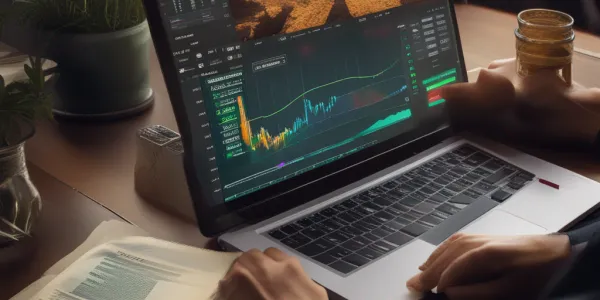Key Factor
Key Factor
Introduction to Key Factor
In the realm of options trading with cryptocurrencies, the term Key Factor plays an essential role. But what is a Key Factor? The Key Factor is a specific point or an element that influences the outcome of an investment. For options trading, this could be the price volatility of the cryptocurrency, market trends, global economic conditions or even the technology behind the cryptocurrency. Understanding and monitoring these factors provides investors with significant insights to make informed trading decisions.
Why is the Key Factor important in Option trading with Cryptocurrencies?
When it comes to option trading with cryptocurrencies, knowing your Key Factors can be the difference between profit and loss. These factors can affect the price of the cryptocurrency option. For example, news about a security breach in a cryptocurrency exchange can cause increased volatility and a fall in price. By keeping an eye on these factors, you could predict such price movements and adjust your trading strategy accordingly.
Example of Key Factors
Let's take a case of Bitcoin options trading. Here, a Key Factor could be the mining rate of Bitcoin. As the mining difficulty increases or decreases, the supply of Bitcoin can be impacted, which may in turn affect its market price. As an options trader, being aware of this dynamic can provide you valuable insights to make fruitful investment decisions.
Conclusion
In summary, a Key Factor is not purely a statistic or a calculated metric. Rather, it is an influential element or variable that can potentially alter the outcome of your investment. In cryptocurrency options trading, having good knowledge and understanding of these Key Factors grandly enables you to make more strategic decisions. Hence, the Key Factor is indeed a significant concept in the landscape of cryptocurrency options trading.
Blog Posts with the term: Key Factor

Crypto options trading, an innovative form of investment that allows traders to buy or sell a cryptocurrency at a specified price and date, is gaining popularity in the US. The Commodity Futures Trading Commission (CFTC) regulates this type of trading;...

The article provides a beginner's guide to understanding the differences between cryptocurrency and options trading, highlighting that crypto trading involves buying and selling digital assets with high volatility while options trading allows speculation on asset prices through contracts without owning...

Option trading profit percentage is a key indicator of return on investment, calculated by comparing the realized profit to the initial option premium while accounting for expenses like commissions and fees. Understanding options, calculating profits correctly, and considering factors such...

Option trading in Germany involves financial instruments that allow buying or selling an underlying asset at a set price before a specific date, with regulated exchanges ensuring market fairness. German traders must understand the difference between call and put options,...

Bitcoin LEAPS options are long-term financial derivatives that allow investors to speculate on Bitcoin's future price with less capital and reduced exposure to short-term volatility. They offer strategic flexibility, cost savings, and the potential for high returns but come with...

Option trading offers two distinct styles: intraday and delivery. Intraday involves quick trades within a single day using leverage, aiming for short-term profits but with high risk due to market volatility; whereas delivery is long-term, seeking asset appreciation and dividends...

Bitcoin binary options brokers allow traders to speculate on Bitcoin's price movement within a set timeframe, offering either fixed returns or losses. Choosing the right broker is crucial for security, fair trading conditions, and support; factors like regulation, reputation, platform...

The Ethereum Merge transitioned the network from Proof-of-Work (PoW) to Proof-of-Stake (PoS), leaving miners with idle hardware and prompting them to seek alternative cryptocurrencies for mining. This article explores various PoW-based alternatives, evaluating their profitability, electricity costs, hashrate efficiency, block...

Option trading losses occur when the premium paid exceeds returns from exercising or selling an option, influenced by market movement, time decay, and volatility. Understanding these losses is crucial for traders to employ strategies like hedging and stop-loss orders to...

Option trading involves contracts granting the right to buy or sell assets at a set price before a certain date, used for hedging and speculation; stock trading is direct share purchasing, offering equity ownership in companies. Both have distinct approaches...

Welcome to the world of crypto options trading! This article provides an introduction to the concept of crypto options trading and discusses various strategies for maximizing profits and managing risks. It also offers tips for choosing a suitable crypto options...

Exit timing in option trading is crucial for maximizing gains or minimizing losses, influenced by factors like market volatility, time decay, and liquidity. Traders must establish a clear exit strategy before entering a trade and adhere to it despite emotional...

Option trading involves buying contracts that give the right to purchase or sell an underlying asset at a set price before expiration, offering strategies for speculation, income generation, or hedging. It requires understanding of market mechanics and risks, with trades...

The article provides an introduction to the cryptocurrency options market, explaining what they are and how they work. It discusses factors that influence cryptocurrency options trading and highlights the potential risks and returns involved. It also offers a glimpse into...

Option trading offline classes offer a structured approach for beginners to learn about options, calls, puts, market strategies, and risk management with direct engagement from experienced instructors. Choosing the right course involves considering personal learning needs and evaluating the provider's...